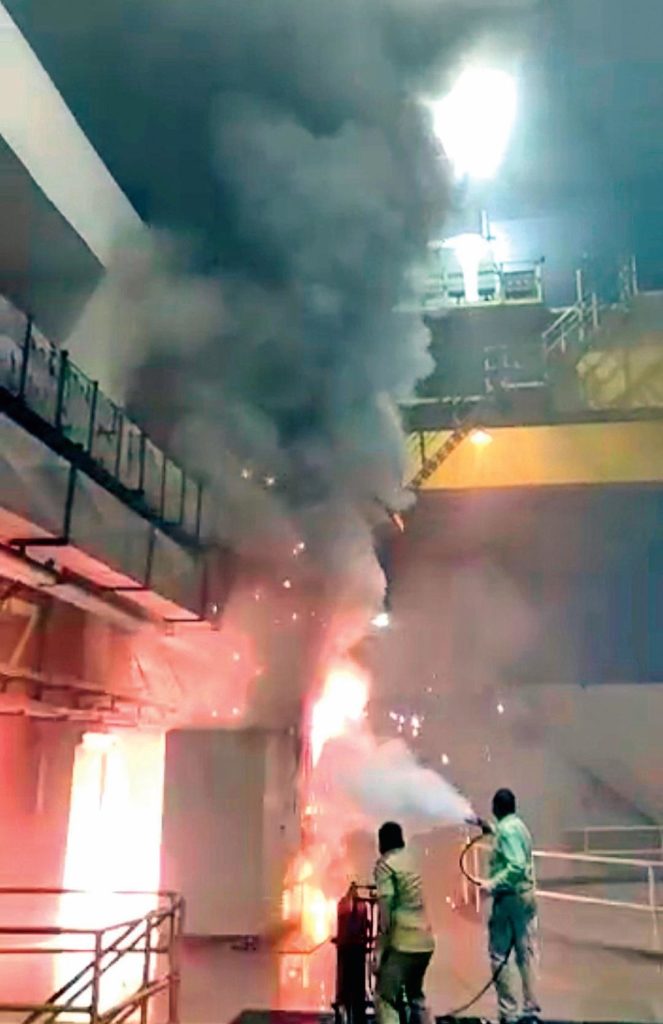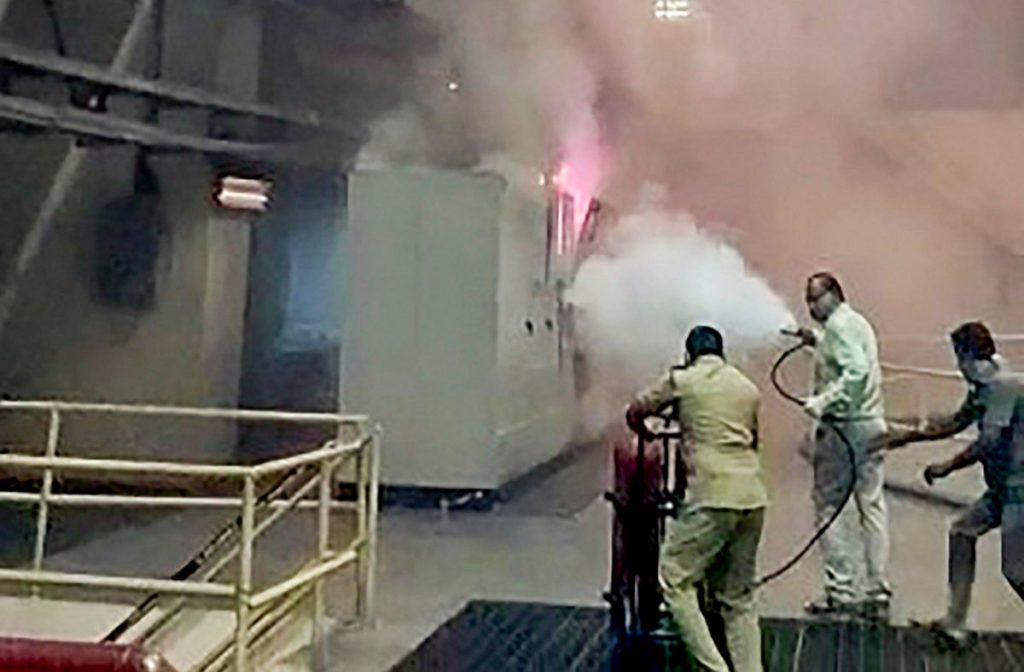Seniors scientists, rythu leaders wrote an open letter to the Chief Minister of Telengana expressing their grief for t he tragic fire and explosion incident at Hydro power station in Srisailam. This letter emailed by Dr EAS Sarma, Former Secretary, Ministry of Power, GoI to Sri K. Chandra Sekhara Rao signed by so many senior scientists and activists and experts.In this letter while these prominent citizens and experts while expressing thier grief for the tragic incident, they brought out certain failures and lapses. They categorically criticised this incident if the result of complete lack of safety culture in TSGENCO. They listed out point by point the reasons they believe caused the tragic loss of 9 lives of young engineers and technical personnel.

These deaths were a result of inadequate safety provisions in the design of the hydropower station building. There is no evidence that this hydropower station was built to international standards such as “Recommended Practice for Hydroelectric Generating Stations, NFPA 851” in absence of any national standards. No safety up gradation was done to meet the current safety standards after two previous flooding incidents (1998 & 2009) and one fire accident in 2019 at the right bank station.
There is no mention of any fire alarm alert to the employees after noticing the fire. All powerhouses require a fire alarm system designed to meet NFPA 72 standard. Were there smoke, heat or flame detectors in the station?
It appears that no fire hazard risk assessment was carried out for the station. Did the station obtain fire safety permission and renewed it regularly?
No emergency action plan and employee training for emergencies such as fire or flood exists. We come to this conclusion based on the failure of the employees to properly conduct an evacuation as per predetermined plan. Life safety comes first in such situations.
There is no fire suppression system. Portable extinguishers were used to fight panel fire. Fire can double in size every 30 seconds and fire extinguishers are inadequate after initial stages of fire. If the employees were trained in fire safety and had at least a rudimentary understanding of fire science, they would have attempted to exit the building immediately after failing to contain fire with extinguishers.
We wonder why a fire engine is kept at the station when water at adequate pressure is available just outside the station. “Hydroelectric facilities have an advantage over their fossil fuel – fired cousins by virtue of having an unlimited
supply of water for fire protection at their fingertips. Medium- and high-head hydroelectric facilities have an added advantage: The water is already under sufficient pressure for fire protection use.” “The application of water to a generator may appear counterintuitive at first glance, but there are no known cases where a properly designed water spray system has caused any significant damage to a generator.” (Dominique Dieken, Power, 2009)
Life Safety Code (NFPA 101) requires: “The employees or attendants of assembly occupancies shall be trained and drilled in the duties they are to perform in case of fire, panic, or other emergency to effect orderly exiting.”
No adequate means of egress. Situation was similar to the Watts Bar plant as described in the fire investigation report. “Personnel working within both the control building and the powerhouse faced challenges in exiting during the fire. As described earlier in this report, the layout and design of the control building resulted in a limited means of egress for personnel in the control building. In the case of this fire, personnel had to pass above the fire to reach the exit. Had there been any significant delay, personnel in the building could have been seriously harmed trying to escape.”
Lessons learned from Watts Bar hydroelectric plant fire in USA in 2002: “One of the most important lessons learned from this fire is the importance of compliance with the Life Safety Code. … There are very few means of egress from the powerhouse, and several places where an employee could be trapped and seriously injured or killed. Worse, there was no emergency lighting, and
employees were plunged into total darkness when the power failed. Only the quick thinking of a floor supervisor ensured the safe exit of employees. As a result of this fire, TVA has realized the importance of the life safety code, and plans to bring all of its hydroelectric plants into compliance.” Conditions in Srisailam plant are similar.

There are standard limits to the maximum distance to a fire escape from any where in the plant based on the fire risk. Exit routes should have adequate emergency lighting for 1.50 hours after the alarm for evacuation is given. Two alternative routes of evacuation are to be provided for escape for each floor.
Fire protection doors with at least two hour fire rating are required to isolate the evacuating personnel from fire and smoke. According to article in “Power’ published in April 2009 on “Fire Protection in Modern Hydropower Stations”: “Powerhouses, other than small ones with only one or two levels, generally require two enclosed stair towers with a two-hour fire rating.”
Investigation report in to Watts bar plant fire shows that similar problems affected the personnel working at the plant during fire. Lack of “frequent training on and demonstrations of emergency and evacuation procedures” at Srisailam led to tragic deaths. “The design of the powerhouse also contributed to existing problems. The building is a large windowless structure, with heavy
3 machinery and other dangers located throughout. It, too, has very limited means of egress, with exits to ground level on the west end and an exit to the top of the dam on the east end. The powerhouse has several levels, both above and below the waterline, with exits located on only one level. (emphasis added) When power to the building was lost, workers were plunged into complete darkness. Personnel would have had to rely on their knowledge of the building and their sense of touch and hearing to exit the building. Luckily, a supervisor on the floor had a flashlight, and was able to find people and lead them safely
from the building. TVA’s review of life safety issues will likely include increased exit lighting per NFPA 101 7.8.1.”
When the generation was shut down without any provision for standby power to emergency services like ventilation and lighting, the effect of smoke became predominant in absence of any exhaust ventilation. Fire also exhausted oxygen to the levels that humans cannot sustain breathing.
.
There are several combustibles like hydraulic and lubrication oils in a hydropower station and they contribute to fire and smoke. Smoke is more harmful than fire as it incapacitates a person in two subsequent breaths without leaving anytime to react. Those remaining in the station were overwhelmed by the smoke and lost life. Proper escape route would have saved those lives. In light of several lapses listed above, any investigation into the accident should involve an independent body of experts in fire protection engineering, fire safety, fire hazard assessment, power generation and related disciplines who do not have any conflicts of interest. Nowhere in the world are such industrial accidents investigated by police officers and career bureaucrats. Fire at Watts Bar Hydroelectric plant in 2002 was investigated by US Fire Administration. Purpose of any investigation is not to blame individuals but to identify human and systemic causes for such incidents to take corrective action to prevent future accidents.
All people of Telangana are stakeholders in the investigation into the incident. Any investigation should involve public consultation. We the undersigned are willing to interact with the investigating expert team and give our inputs online or in person. Investigation reports should be made public. We are also unable to agree with valuing the dead differently in payment of compensation. Real world is suffering from severe social and economic inequalities that are causing concern to eminent economists like Prof Stiglitz, Thomas Pikety, Emanuel Saez, Herman Daly and others. We have conditions that reflect the
description in Charles Dickens’s “Tale of Two Cities”. Let us at least treat all the dead in the incident as equals. All Indians are equal as enshrined in our constitution.
We urge the government of Telangana to begin safety audit for the hydropower stations in our state and implement all relevant international safety standards as highlighted in points above at all these stations. We humbly urge you to understand our anguish and concern at the loss of lives and property and a desire for a professional investigation as is done in the developed world. Development is not merely increasing wealth. It also implies developing a culture that sustains that wealth generation.
Projects
In this letter they clearly highlighted the lack of safety measures and absence of proper training to the staff etc. They urged the government of telengana to beging safey audit for the hydropower stations and implement all relevant international safety standards . They also expressed their desire for a professional investigation as is done in the developed world. Hope Chief minister of Telengana took in to consideration the advise of the elders and experts to avoid such incidents in future.
The other prominent gentleman signed are Justice Chandra Kumar, President, Telangana Rythu Sankshema Samithi Dr Sandeep Pandey, Ramon Magsaysay Awardee,Capt J. Rama Rao, Indian Navy (Retd)Sagar Dhara, Former UNEP ConsultantShankar Sharma, Power Policy ExpertHimanshu Thakkar, South Asia Network on Dams and River Projects Dr Lubna Sarwath, General Secretary, Socialist Party of India, Telangana Scientists for PeopleHuman Rights ForumJana viignana VedikaIndia March for Science, TelanganaTelangana Vidyavantula VedikaNational Alliance of Peoples Movements, TelanganaSouth Asia Peoples Action on Climate Crisis(Dr K Babu Rao) (Dr K Venkat Reddy)Scientists for People.




